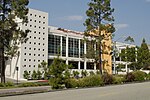Chadwick School
1935 establishments in CaliforniaEducational institutions established in 1935Preparatory schools in CaliforniaPrivate K–12 schools in Los Angeles County, California

Chadwick School is a nonsectarian independent K-12 day school located in an unincorporated area on the Palos Verdes Peninsula in Los Angeles County, California, United States. Specifically it is located at the top of the neighborhood referred to as Academy Hill, which is bounded by a canyon, a precipice, Crenshaw Boulevard, and Palos Verdes Drive North.
Excerpt from the Wikipedia article Chadwick School (License: CC BY-SA 3.0, Authors, Images).Chadwick School
Cartesian Circle, Unincorporated Rolling Hills Estates
Geographical coordinates (GPS) Address Website External links Nearby Places Show on map
Geographical coordinates (GPS)
| Latitude | Longitude |
|---|---|
| N 33.776666666667 ° | E -118.36111111111 ° |
Address
Chadwick School
Cartesian Circle 26800
90274 Unincorporated Rolling Hills Estates
California, United States
Open on Google Maps






